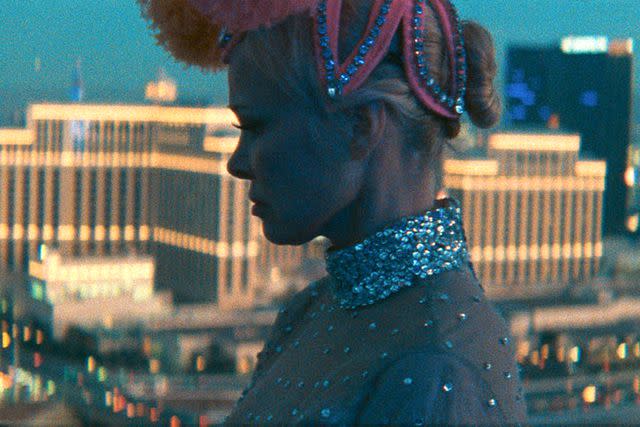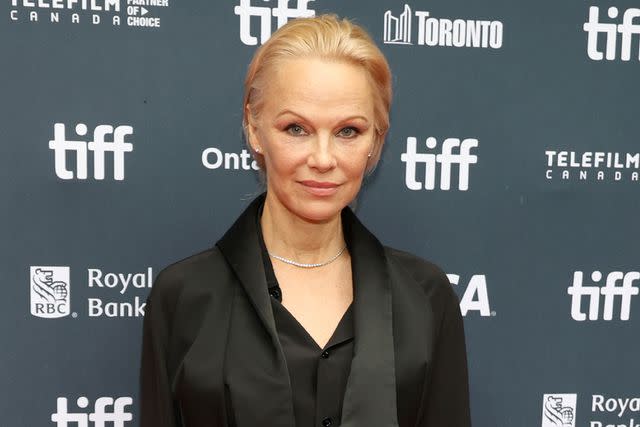Pamela Anderson sparkles in poignant Las Vegas tale of “The Last Showgirl”
The former "Baywatch" star gives an award-worthy performance that channels her Hollywood history.
Pamela Anderson, Oscar nominee, is probably not a combination of words most people thought they would ever hear. But with her raw and beautiful performance in The Last Showgirl, it just might happen.
The film, which premiered at the Toronto International Film Festival on Friday, tells the story of Shelley (Anderson), a showgirl at Vegas' Le Razzle Dazzle who has devoted the last 30 years of her life to a parade of sequins, rhinestones, and feathers. When producers suddenly announce plans to close, it leaves Shelley searching for purpose as she flounders in the hunt for a new job alongside fellow showgirls Jodie (Kiernan Shipka) and Mary-Anne (Brenda Song).
Shelley wrestles with her strained relationship with her daughter, Hannah (Billie Lourd), and tries to untangle complicated feelings for the show’s stage manager, Eddie (Dave Bautista), all while searching for what comes after the thing she has dedicated her life to ends.
The script from Kate Gersten (The Good Place, Schmigadoon!) carries a contemplative tone that allows director Gia Coppola’s camera to linger on its subjects, capturing the layered beauty of these women and the fractured sequins of their lives. Gersten spent time with the showgirls of the Jubilee, the last show of its kind in Vegas, in the days leading up to its final performance, and the specificity of that experience is evident in the script.

Courtesy of TIFF
Pamela Anderson in 'The Last Showgirl'Coppola and Gersten never frame these women (and Eddie) as people to be pitied. There’s heaps of compassion and empathy for the harsh reality of their lives and the places their dreams have led them. But we’re not asked to feel sorry for them, only to understand them and the myriad of choices that have brought them to this point. As the next generation of the Coppola directing legacy (she’s granddaughter to Francis and niece to Sofia), Gia has a lyrical quality all her own, while still engaging with questions of the American Dream and femininity, themes that have preoccupied her family members.
But with her lilting camerawork and her use of Las Vegas symbols (there are multiple visits to a fading statue of Pinocchio’s Blue Fairy), she crafts an elegy to a Vegas of a different era and the tarnished reality of once sparkling dreams.
Anderson is the perfect choice for Shelley. She said herself that once she read the script she believed no one else could play this role — and she’s right. Her own history as a sex symbol lends Shelley a richly fraught context, one Anderson gets to interrogate and twist like a glittering kaleidoscope with her performance. With her distinctive babydoll voice, Anderson grants a lost little girl quality to Shelley, while also imbuing her with something more maternal and world-weary. Shelley is the Blanche DuBois of showgirls, a dancer gone to seed as all she ever wanted slips through her fingers. But she will not allow the world to break her in the same way.
Related: Pamela Anderson says she's never watched stolen sex tape with Tommy Lee: 'It was very hurtful'
Shelley believes that what they do at Le Razzle Dazzle is art, with roots in Parisian folies de berger and their ilk. She won’t apologize nor demean the show she loves so dearly, even if others see it as low-class and tacky. Shelley refuses to be objectified, choosing instead to own her sexual glamor. Her commitment to her work and unwavering belief in its worth imbues her performance with dignity, even if the audience — and her fellow dancers — can’t always see it.
Through Shelley, Coppola and Gersten make an argument that seems to need to be reiterated time and again — work centered on sexuality and women and desire is as worthy of artistic appraisal and appreciation as anything else. Be it dancing in a “tits and feathers” show, making a movie about showgirls, writing a romance novel, or owning one’s sexuality on television and magazine covers as Anderson once did.
Related: Pamela Anderson is 'ready to tell her story' with new Netflix doc: 'Not a victim, but a survivor'
The Last Showgirl probes complex notions of womanhood and identity as Shelley both rejects and invites a maternal status amongst the younger gals she dances with. Her daughter, Hannah, is barely involved in her life, having chosen to remain living with family friends after Shelley refused to give up the show to raise her. Lourd is arresting as a haunted, world-weary girl, who clearly craves a connection with her mother but is looking for something that Shelley simply does not have to give. Lourd has spoken about the ways in which the film echoes the infamous relationship between her mother, Carrie Fisher, and grandmother, Debbie Reynolds, and that history adds a palpable weight to the action.
To be a woman is to sacrifice — be it for your career, your children, your dreams, or some combination of all that. But The Last Showgirl pushes that truth further, forcing us to examine what sacrifices our society deems valid or acceptable — and whether or not we can ever know if we’ve made the right choice when presented with impossible decisions.

Kayla Oaddams/Getty
Pamela Anderson at TIFFThere’s not a weak performance in the bunch, be it Bautista’s wounded Eddie, who is as hungry for connection as any of the girls he works with, or Jamie Lee Curtis’s Annette, a retired showgirl and cocktail waitress. Of late, Curtis has wowed audiences with her lack of vanity, most notably in her Oscar-winning performance in Everything Everywhere All at Once, but The Last Showgirl is her rawest, most impressive work yet.
Annette is a garish figure, spray-tanned to match the Vegas desert sand, as she squeezes herself into cocktail uniforms and low-cut tops that express her futile attempts to cling to her youth and beauty. Curtis makes Annette a bawdy figure, always quick with a quip and comic relief — until she isn't. In a striking moment, Annette takes to a small stage on the casino floor and dances to “Total Eclipse of the Heart,” her desperation and need for adulation oozing from every pore. It’s a heart-rending, uncomfortable moment, and Curtis doesn’t blink, leaning into it with vulnerable abandon.
“It’s a hard life wherever you go,” Curtis noted after the premiere, a statement that could be the film’s thesis. Shelley, Annette, Eddie, and the rest of this motley crew are simply doing their best, trying to make it through the harsh realities of their hard lives.
Want more movie news? Sign up for Entertainment Weekly's free newsletter to get the latest trailers, celebrity interviews, film reviews, and more.
Near the film’s climax, Shelley declares, “I’m beautiful,” invoking her self-worth and inner light in the face of those who can’t see beyond the shallowest definitions of beauty. Anderson, 57, just like Shelley, comes alive in a breathtaking merging of performance and person in that moment, thumbing her nose at those unable to see her skill as an actress or her contributions to entertainment beyond her capacity for objectification and exploitation.
The Last Showgirl is a requiem for any woman who has ever been underestimated because of her beauty, her choices, or her art (so, essentially, every woman ever to exist). But it’s also a triumphant proclamation that no matter how faded your sequins or dull your rhinestones, no one can take away or diminish a loving heart, particularly when one has the strength to turn it inwards. Grade: A
Read the original article on Entertainment Weekly.
